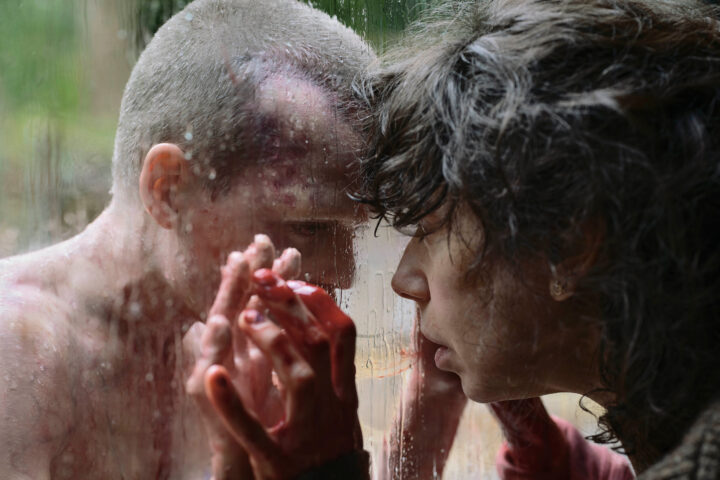In a few short years, Elizabeth Moss has cornered the market on emotionally fraught, through-the-ringer screen characters, from The Handmaid’s Tale’s subjugated Hester to Her Smell’s strung-out rocker and The Invisible Man’s tormented object of obsession. In her latest portrait of turmoil, Moss is a semi-fictional version of celebrated Gothic novelist Shirley Jackson, and again, memorably haunted. But shouldn’t all famous novelists who are both celebrated and reviled be entitled to go a little crazy?
Shirley, filmmaker Josephine Decker’s measured psychological mystery, is a story of gamesmanship told with, at times, an eerie sleight of hand in its contemplation of the artistic process and its symbiosis with the actual. Inspiration, as any artist will tell you, is both symmetrical to the events of one’s life and flight of fancy, sprung from the tenuous tension between real and imagined. And by its final reel, Decker’s unconventional movie, a showcase for Moss, will keep you guessing as to which one is up her sleeve.
Adapted from Susan Scarf Merrell’s well-received 2014 book Shirley: A Novel, we first meet Jackson as a housebound neurotic, holed up in her Vermont bedroom with English professor husband and enabler Stanley (terrific Michael Stuhlbarg), a marriage of convenience informed by control and open infidelity, an arrangement that one party flagrantly abuses. Well matched actors, the pair set off marital fireworks upon the arrival of a live-in, fictional couple of married interlopers.
Thrust into Shirley’s home and volatile equilibrium are bright young teaching protégé Fred (appealingly low-key Logan Lerman) and pregnant wife Rose (Odessa Young), and the picture has fun with Shirley’s unwelcoming demeanor, a sardonic revulsion at the innocuous strangers in her house. There’s some sharpness in the Who’s Afraid of Virginia Woolf? set-up, the wide-eyed innocents thrown to the wolves of Shirley’s caustically biting judgments.
With Fred under Stanley’s academic tutelage, Rose plays requisite housemaid to the home’s chores, an earn-your-keep arrangement at Shirley’s beck and call. Put out Shirley, who has just achieved a modicum of notoriety for her 1948 The New Yorker short story The Lottery, commences writing a new novel, and Moss’ hair-trigger, nerve-frayed neurosis is fun to watch.
Sarah Gubbins’ economical screenplay does a good job of establishing the suffocating dynamics of the family home, where most of the action takes place, as one of both isolation and eventual inspiration. Like most movies about artists, the trick is always to effective depict the creative, spiritual journey from idea to execution, to make the abstract literal as narrative. Decker almost succeeds.
As a writer of short stories, it remains to be seen whether Shirley can pull of an entire novel (later known as The Hangman). And while Odessa may be an enlisted worker and initial point of nuisance, the pair quick develop a begrudging, mutual fascination, a complicated dance that comes close to friendship, or perhaps fodder.
Clearly, the relationship is intended as a sisterhood during a period of oppression for American women, a suggestion that beneath their wifely veneers and expected societal roles lurked suppressed desires, courageous creativity and an intense need to shatter pretense. While this pairing may manifest as art for Shirley, for Rose it achieves something like an awakening, able to ultimately see her husband’s considerable foibles and take agency in her own life. As her hapless husband, Lerman, a gifted young actor, is somewhat hamstrung by a thinly conceived role, and the younger couple’s marriage – lack of intimacy and eventual drifting – only snapping into focus and meaning during in the final reel.
Rose, who in the film’s opening scenes becomes aroused upon reading The Lottery and entices husband Fred into public restroom sex on a speeding train, immediately hints at something more adventurous that Fred himself has overlooked. Shirley, after rebuffing Odessa’s early politeness and friendship, eventually sees Odessa’s darker corners, and embraces their symmetry.
The picture also convinces when it explores the dynamics between Shirley and Stanley, a progressive union of arts and letters, alternately eschewing marital constructs like commitment while bordering on controlling obsession. Stuhlbarg, the most articulate of actors, is vividly persuasive in managing Shirley’s frequent outbursts. Shirley is clear about its aloof, caddish, controlling men. And while Shirley herself has long resigned the role of subservient wife, she remains a victim of public embarrassment from a passive-aggressive, carousing husband, alternately supportive and skeptical of her artistry.
This is a heady cocktail to be sure, filled with mysteries and ideas related to art, gender and non-conformity. Yet while the movie is conceptually intriguing, it never quite engages on a visceral level. It’s studied, measured and often remote, as if preserved beneath glass. Shirley is a strange, remote and holds its secrets for quite some time. Yet what would one expect from a picture about the mastermind of The Haunting of Hill House?
2 1/2 stars.



